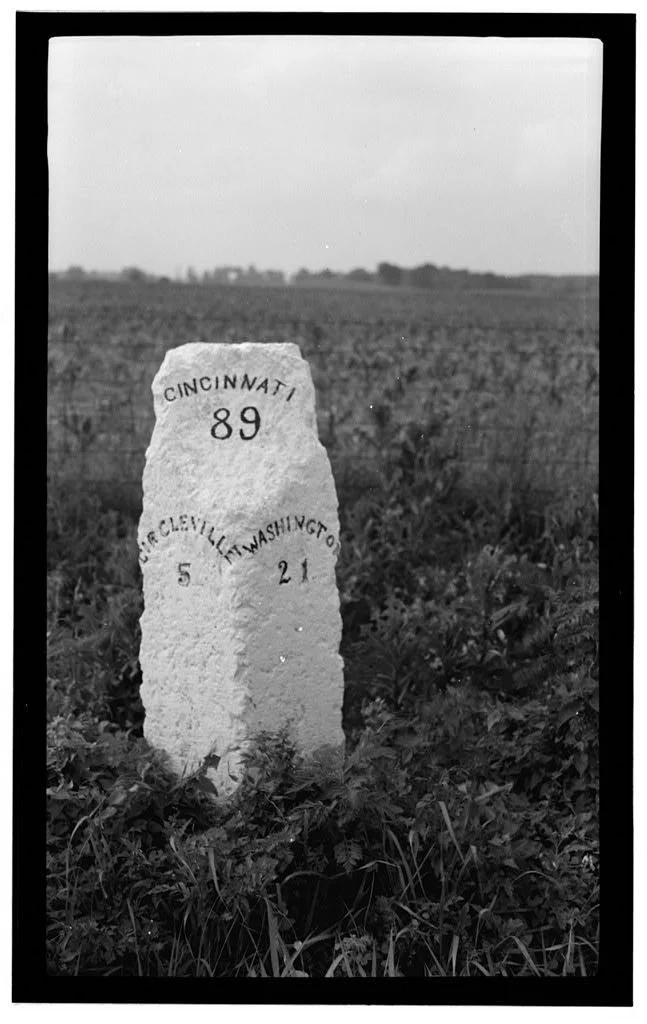Wagon Road: Zane’s Trace
Zane's Trace was one of the first frontier roads in the United States, built under the supervision of Colonel Ebenezer Zane in the late 1700s. This road played a vital role in facilitating westward expansion and migration.
Ebenezer Zane (Oct. 7, 1747 - Nov. 19, 1812), a notable pioneer, was born on a farm along the South Branch of the Potomac near present-day Moorefield, Hardy County, West Virginia. His father had moved to the Potomac Valley after being expelled from a Quaker meeting in eastern Pennsylvania for marrying outside the Society of Friends. Little else is known about Zane's parents. In the same year that the frontier to the Ohio River was officially opened by the Iroquois cession at the Treaty of Fort Stanwix, Ebenezer came of age. Already familiar with these lands through exploration with his brothers, Silas and Jonathan, he led the westward expansion in 1769 by claiming land at the mouth of Wheeling Creek under Virginia law. The following year, they brought their families to settle the area.
The Wheeling settlement emerged as a vital Ohio River terminus for the road from Cumberland, Maryland, which saw a growing number of emigrants moving westward.
Ebenezer Zane was heavily involved in land speculation, a contributing factor to Dunmore's War, although he opposed the violent acts against Native Americans that led up to it. During the war, he served as a colonel and disbursing agent for the Virginia militia at Fort Fincastle in Wheeling. Zane supported the Patriot cause during the American Revolution, playing a significant role in defending Fort Fincastle—later renamed Fort Henry—against British and Indian attackers in 1777 and 1782. His sister, the renowned Betty Zane, famously braved enemy gunfire during the 1782 siege to fetch an apron-load of gunpowder from a nearby storehouse to the fort. Meanwhile, his brother Jonathan gained extensive knowledge of Ohio lands while serving under Crawford in the Sandusky expedition of 1782.
In the late 1700s, Zane and his brothers followed Native American footpaths to blaze the first road through the wilderness of the Northwest Territory. Colonel Ebenezer Zane, founder of Wheeling, West Virginia, and a key figure in settling Lancaster, Ohio, petitioned Congress for permission to build a road. He received approval in 1796, after he had already started the project. To cover his surveying costs, Zane requested and was granted land at the points where the road crossed the Muskingum, Hocking, and Scioto Rivers. The government believed that the road, opened in 1797, would attract more settlers to Ohio and boost trade.
Zane's Trace, now part of the National Road and Route 40, was the most direct route between Wheeling and Limestone (present-day Maysville), Kentucky, on the Ohio River.
Initially, Zane's Trace was only wide enough for a horse and rider, not a wagon. Recognizing the need for river transportation, Zane established ferries at each river crossing. After building a ferry at the mouth of the Licking River, a small town emerged, eventually named Zanesville. Today, Zanesville is the county seat and largest city in Muskingum County.
After the American Revolution, Ebenezer Zane continued his land speculation activities. Between 1785 and 1787, he frequently hosted U.S. surveyors of the Seven Ranges and, along with his brother Jonathan, engaged in salt production at the Muskingum River Salt Licks, located ten miles below present-day Zanesville, Ohio. Following the 1795 Treaty of Greenville, which ceded southern Ohio lands from the Native Americans, Zane requested permission from Congress in March 1796 to construct a road from Wheeling to Limestone, Kentucky. On May 17, 1796, Congress approved his request, granting him three square-mile lots where the road would cross the Muskingum, Hocking, and Scioto Rivers, provided he complete the road by January 1, 1797, pay federal bounty warrants equal to the granted acreage, establish ferries at each river crossing, and survey the tracts at his own expense.
The towns of Zanesville and Lancaster were established on two of these tracts in 1799 and 1800, respectively. The third tract was located across the Scioto River from Chillicothe.
Zane married Elizabeth McCulloch before leaving the South Branch of the Potomac and fathered thirteen children. He was laid to rest in the Zane family cemetery near Martin's Ferry, Belmont County, Ohio, close to Wheeling.
In 1800, the road from Wheeling to Zanesville was widened, but it remained steep and rutted, making travel challenging. Despite these difficulties, Zane's Trace was the only major road in Ohio until after the War of 1812.
In 1803, following Ohio's statehood, the state legislature allocated funds to improve Zane's Trace for wagon travel. Trees were cleared to widen the road to 20 feet, and bridges were constructed. This made it possible to travel by wagon from Wheeling to Chillicothe. Settlements began to appear along the route, with businesses such as taverns and inns serving travelers. Farmers also used the road to transport their crops to market.
In Lancaster, Ohio, Zane's Trace crossed the Hocking River. The road was crucial for German settlers traveling westward, many of whom came from Pennsylvania. The influx of German settlers was so significant that by 1809, Lancaster had a German-language newspaper, Der Ohio Adler.
Today, the National Road and Route 40 incorporate parts of Zane's Trace. The section between New Concord and Zanesville is still drivable, except for a portion near the Zanesville Airport. This narrow, winding road offers a glimpse of what the National Road and Route 40 were like before the extensive roadbuilding efforts of the 1930s.
Milestone of Zane's Trace, Route 22, Kinderhook, Pickaway County, OH (Library of Congress, Loc.gov)
